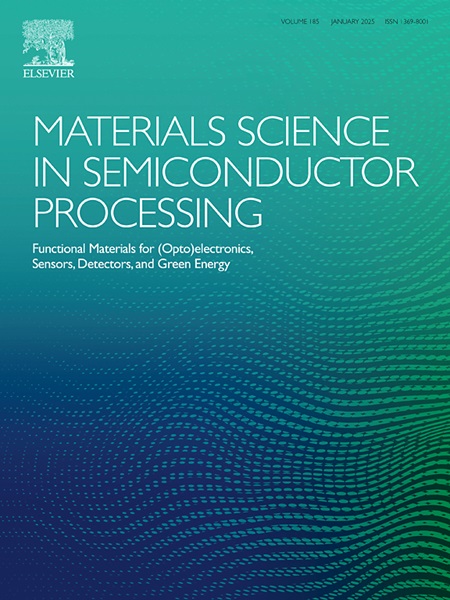Enhanced photocatalytic water-splitting performance of Fe/CdS nanomaterials: Structural, optical, and electrochemical insights
IF 4.6
3区 工程技术
Q2 ENGINEERING, ELECTRICAL & ELECTRONIC
引用次数: 0
Abstract
Photocatalytic water splitting using semiconductors for sustainable hydrogen production is a promising technology. Fe/CdS photocatalysts with varying Fe doping levels were synthesized and systematically characterized. The samples prepared via hydrothermal synthesis were then subjected to comprehensive structural, optical, electrochemical, and photocatalytic analyses. Fe doping induced slight shifts in X-ray diffraction (XRD) peak without altering the CdS crystal structure. The bandgap was reduced from 2.35 eV to 2.19 eV by increasing the Fe doping, enhancing visible-light absorption. X-ray photoelectron spectroscopy confirmed the incorporation of Fe into the CdS lattice. Electrochemical studies showed improved charge-transfer kinetics and redox peaks in cyclic voltammograms. Fe/CdS (0.20:1) achieved the highest hydrogen evolution rate at 54.75 mmol/g/h under visible light, outperforming pristine CdS (30.01 mmol/g/h) and FeS2 (34.19 mmol/g/h). Stability tests over multiple hydrogen evolution cycles revealed structural integrity and activity retention, which were confirmed by XRD. Fe/CdS photocatalysts are promising for efficient water splitting because of their enhanced optical properties, charge-separation efficiency, and electrochemical activities. Optimization of Fe doping is crucial for maintaining a high photocatalytic efficiency and advancing renewable energy technologies toward greener systems.

Fe/CdS纳米材料增强光催化水分解性能:结构、光学和电化学见解
利用半导体进行光催化水分解可持续制氢是一项很有前途的技术。合成了不同Fe掺杂水平的Fe/CdS光催化剂,并对其进行了系统表征。通过水热合成制备的样品然后进行了全面的结构,光学,电化学和光催化分析。Fe掺杂使CdS的x射线衍射峰发生了轻微的位移,但没有改变CdS的晶体结构。通过增加Fe掺杂量,使带隙从2.35 eV减小到2.19 eV,增强了可见光吸收。x射线光电子能谱证实了铁与CdS晶格的结合。电化学研究表明,循环伏安图中的电荷转移动力学和氧化还原峰得到了改善。在可见光下,Fe/CdS(0.20:1)的析氢速率最高,为54.75 mmol/g/h,优于原始CdS (30.01 mmol/g/h)和FeS2 (34.19 mmol/g/h)。经过多次析氢循环的稳定性测试,证实了其结构完整性和活性保持性。Fe/CdS光催化剂具有较强的光学性能、电荷分离效率和电化学活性,有望用于高效的水分解。铁掺杂的优化对于保持高光催化效率和推进可再生能源技术向更环保的系统发展至关重要。
本文章由计算机程序翻译,如有差异,请以英文原文为准。
求助全文
约1分钟内获得全文
求助全文
来源期刊

Materials Science in Semiconductor Processing
工程技术-材料科学:综合
CiteScore
8.00
自引率
4.90%
发文量
780
审稿时长
42 days
期刊介绍:
Materials Science in Semiconductor Processing provides a unique forum for the discussion of novel processing, applications and theoretical studies of functional materials and devices for (opto)electronics, sensors, detectors, biotechnology and green energy.
Each issue will aim to provide a snapshot of current insights, new achievements, breakthroughs and future trends in such diverse fields as microelectronics, energy conversion and storage, communications, biotechnology, (photo)catalysis, nano- and thin-film technology, hybrid and composite materials, chemical processing, vapor-phase deposition, device fabrication, and modelling, which are the backbone of advanced semiconductor processing and applications.
Coverage will include: advanced lithography for submicron devices; etching and related topics; ion implantation; damage evolution and related issues; plasma and thermal CVD; rapid thermal processing; advanced metallization and interconnect schemes; thin dielectric layers, oxidation; sol-gel processing; chemical bath and (electro)chemical deposition; compound semiconductor processing; new non-oxide materials and their applications; (macro)molecular and hybrid materials; molecular dynamics, ab-initio methods, Monte Carlo, etc.; new materials and processes for discrete and integrated circuits; magnetic materials and spintronics; heterostructures and quantum devices; engineering of the electrical and optical properties of semiconductors; crystal growth mechanisms; reliability, defect density, intrinsic impurities and defects.
 求助内容:
求助内容: 应助结果提醒方式:
应助结果提醒方式:


